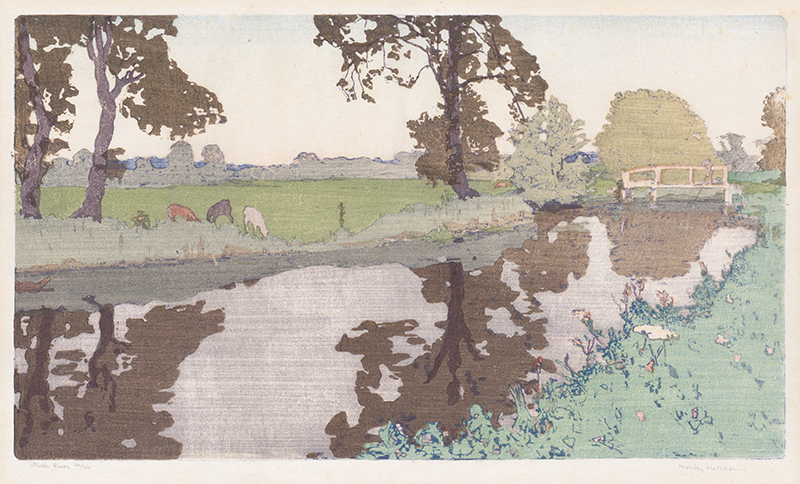
19th, 20th & 21st Century Fine Prints
707-546-7352 · fax 707-546-7924 · web: www.annexgalleries.com · email: artannex@aol.com
Wiston River by Frank Morley Fletcher

Wiston River
Frank Morley Fletcher
Wiston River
Frank Morley Fletcher
1866 - 1949 (biography)This Japanese inspired color woodcut by Frank Morley Fletcher was done around 1911. Fletcher was born in Whiston, England in 1866 and this woodcut of the Wiston River, one of a number of prints he did that evoked his native South Yorkshire. At this time he was teaching at the University College, Reading School of Art. Fletcher taught the color woodcut process to Allen Seaby, John Platt , B.J.O. Nordfeldt, and many others.
Fletcher, like his American counterpart, artist Arthur Dow, carved and printed his own woodcuts, experimenting with the color within the editions which were typically 75 to 100 (this is numbered 42/100) impressions.
Cornell Curator Nancy E. Green commented about Fletcher's work: "Muted colors are often contrasted with saturated bright greens and turquoise; in this he paid homage to Puvis de Chavannes, the French artist Fletcher admired (above all others) for his selection of beautiful tones and colors for the spiritual harmony found in all his works."
Frank Morley Fletcher was born in Whiston, Lancashire, England on 25 April 1866. He was educated at the University of London and his artistic training continued in England at St. John's Wood Art School and at the studio of Hubert Vos.
By 1888 Fletcher was in Paris and resumed his studies at Atelier Cormon, where he made the acquaintance of American artists Albert Herter and Fernand Lungren. During this interval he was introduced to Japanese woodblock prints. Returning to England, Fletcher began to cut blocks for J.D. Batten and he continued to assimilate the complexities, subtleties, and aesthetics of the Japanese woodblock print. Fletcher's first woodcut, Meadowsweet, was produced in 1897. He was also deeply interested in the ideas and aesthetics of the Design and Industries Association and applied these ideals to his own work.
Returning to London, he was appointed to the position of inspector of all art schools in the South of England. Fletcher also was head of the Art Department of University College, Reading, between 1898-1906, where he taught woodcut artist Allen Seaby. He was appointed to the prestigious position of Director of the Edinburgh College of Art in 1907. In 1916 Fletcher's treatise, Wood-Block Printing, was published in London, the first mass printing in English of the technique of color woodcut. Many aspiring woodcut artists took guidance from his book in setting up a studio and printing.
In 1923, Herter and Lungren persuaded Fletcher to immigrate to the U.S. and direct the newly established School of the Arts in Santa Barbara, California. Unfortunately he gave up his pension in England to move to America to teach, only to see the school fail in 1930 with the onset of the Depression. Fletcher relocated to Los Angeles where he continued to teach and paint and then moved to Ojai, California in the 1940s. Frank Morley Fletcher died in Ojai, California on 2 November 1949.


